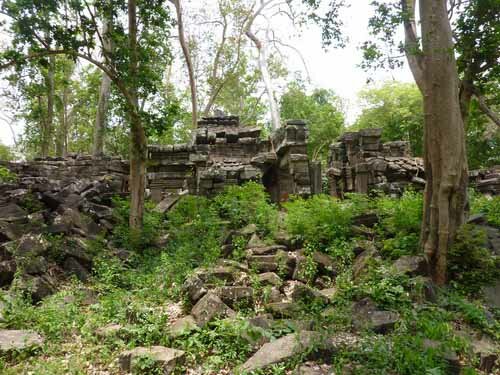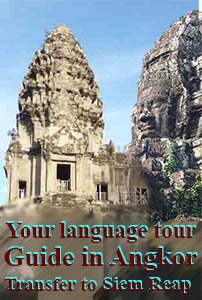


Banteay Chhmar
បន្ទាយឆ្មារ
If the symbols are not visible downlad a khmer font
Date: Late 12th-early 13th century.
King: Jayavarman VII.
Cult: Buddhist.
Best time for seen: Visit the eastern bas-reliefs when you arrive in the morning, then visit the temple. The western bas-reliefs are best seen after 12 PM. Do not miss: The bas-reliefs; the pediments in the Hall of Kinnaris; the few remaining face-towers; the images of Buddha left intact at Banteay Chhmar.
The temple Banteay Chmar located near the village of 14 households with the same name and located in the Thma Puok district of Banteay Meanchey province in 63 km to northwest of Sisophon city and 20 km east of the border with Thailand.
You have quite a rare opportunity to see the ancient Khmer temple of such size and such values untouched by the restoration to evaluate the huge long-term work at the beginning of the French curators and conservators of Angkor, such as Jean Commaille, Henri Marchal and Maurice Glaize and the whole world now taking part in the reconstruction but only the central Angkor.
Banteay Chhmar is one of the largest temple-city complexes built by a Khmer kings. It is also one of the most interesting. The temple, surrounded by large moats, was accessed through four causeways lined with devas and asuras holding a snake, as in Preah Khan.
Banteay Chhmar features face-towers and bas-reliefs similar to those found at the Bayon, images of Buddha which escaped the Hindu reaction and several pediments depicting scenes rarely found elsewhere. All these elements create a unique combination.
The temple is in a bad state of preservation as no restoration effort was conducted at Banteay Chhmar in the 20th century. Entire sections of the bas-relief galleries have fallen to the ground. As the stones still lie at the exact place where they fell one cannot wait for these sections to be reassembled, revealing scenes which have now been hidden for decades, if not centuries.
An inscription tells us that one of the sanctuaries was dedicated to a crown prince, Srindrakumara. and to four army officers who died in batdes, two of them while defending King Yashovarman II, the two others while protecting Srindrakumara.
Eight satellite sanctuaries, some featuring face-towers, were built around the main temple, two of them outside the city limits.
The temple was not built at the centre of the space defined by the surrounding moats, but slightly off the north. The southern section is larger but an asymmetry often found in Khmer temples

Huge baray now looks like a swamp precedes the temple to the east and slightly to the north of the east-west axis of the temple and met us on the way to the temple. As usual for khmer barays it has a sanctuary - Mebon in the center
Entrance on the east side is the one and main. The woman in the picture under the umbrella does not check the tickets but collecting donations to Buddhist New 2557 Year.


The entire temple is surrounded by a huge moat as in Angkor Wat

The ranks of Devas and Asuras holding naga once stood here as in Angkor Thom and Preah Khan at the present moment has long been stolen by thieves on the east - the main entrance but remained at the northern entrance through which one can not enter now. The Buddha images on the wall above the entrance escaped destruction during returning of Hindu religion.
North entrance
Detail of the east entrance

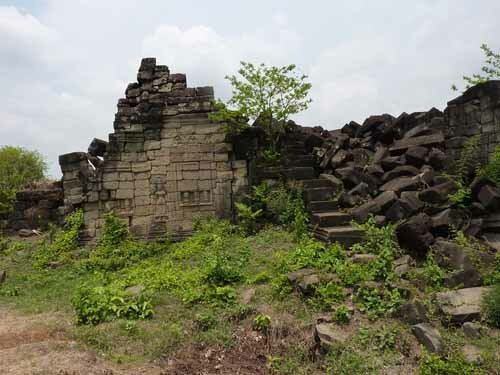
Dharmasala with own plan similar to the same as at Ta Prohm and Preah Khan. It has a pretty rough construction and the lack of any decorating carving on the building.
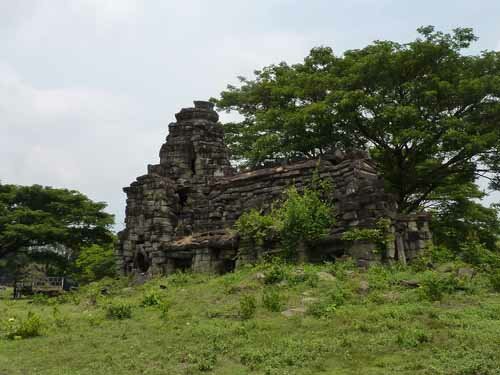

At the eastern entrance were beautiful garuda-naga balustrades because for a long time were buried under the ground
The temple can be reached through the main gate, the mark 1A or alternation eastern entrance through a doorway made in the wall with bas-reliefs mark 1 on the plan below.


Inner Temples
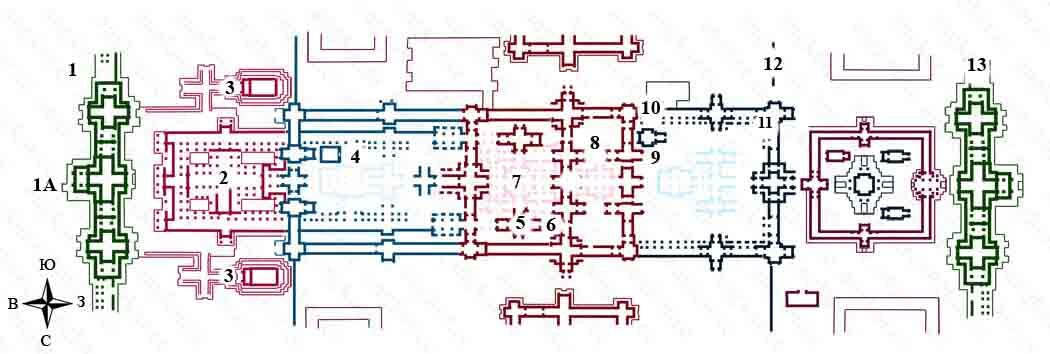
Mark 2 Eastern section named the " Hall of Kinnaris" includes some quite beautiful and interesting pediments (details below).
Mark 3.. On both sides of the Hall of Kinnaris there is ruins of temples built on high ground decorated with lions and Garudas in the pose of Atlantis the same as in the Terrace of Elephants in Angkor.
Mark 4. The large library. At the top remains the left lower part of the well-preserved pediment depicting the demon Ravana shaking Mount Kailasa.


Mark 5. Well-preserved tower with faces added later headed the northern pediment of the neighboring sanctuary. This explains why a beautiful pediment depicts the Buddha meditating under the protection of hood of nagas queen Mukalinda located inside the tower with faces! This sanctuary was fully restored in 2012.

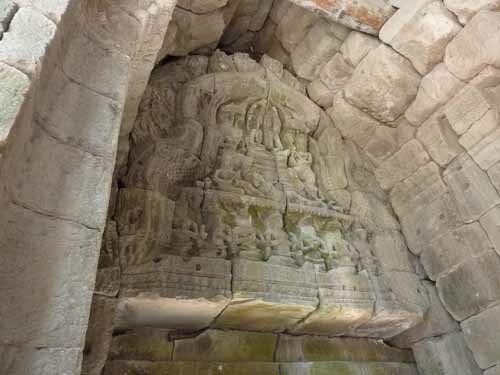
Beautiful gallery leads to the tower with faces of Buddha and beautifully decorated of octagonal columns and carved pilasters door of the tower.


Mark 6. A little Buddhas at the top of the wall.
Mark 7. The now collapsed central sanctuary was not larger than the two other sanctuaries flanking it.

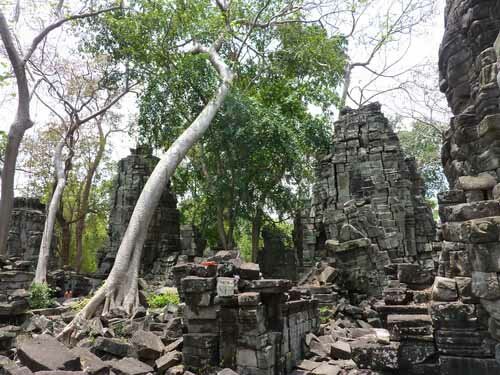
Mark 11. At the south-east corner face-tower was still standing only by a miraculous balancing act. The fact that it will collapse unfortunately only a matter of time and can occur at any time so keep a safe distance during your visit.
Mark 8. Pediment: A standing Lokeshvara, head missing
Mark 10. Unclear composition on the tower pediment. The central figure overwritten apparently by religious fanatics of other faiths. Most likely it is sitting on a throne Buddha. Two figures of worshipers sit on the sides from the front and two on the edges of the profile.
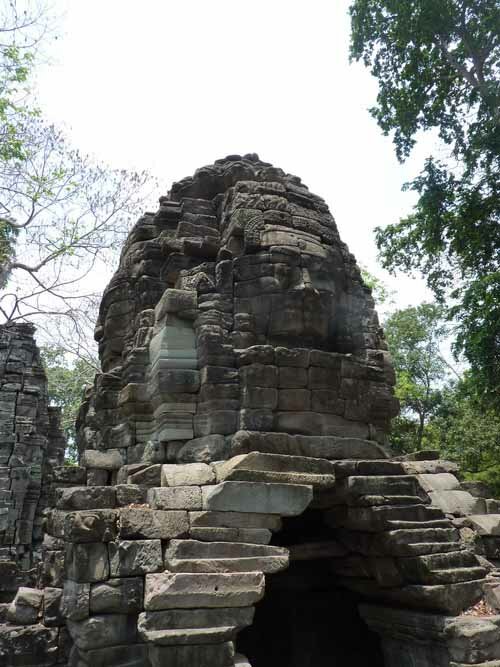


Mark 9. On the north side of the sanctuary topped by a tower with four faces to the four-handed Bodhisattva seated on the throne.

Mark 12. A frieze of Buddhas decorates the top of the laterite wall. In Angkor these Buddha images were destroyed.
Mark 13. The exit on the western side where you will find, on each side of the door, a magnificent multi-armed Lokeshvara



Hall of Kinnaris
The structure of this section reminds Hall of Dancers in Ta Prohm and Preah Khan but decorating friezes Apsaras there was been replaced by Kinnaras here- half woman, half bird - mythical creatures, singers and musicians who lives in heaven with the Gandharvas and Apsaras.

Entrance to the Hall of Kinnaras in front and in back side

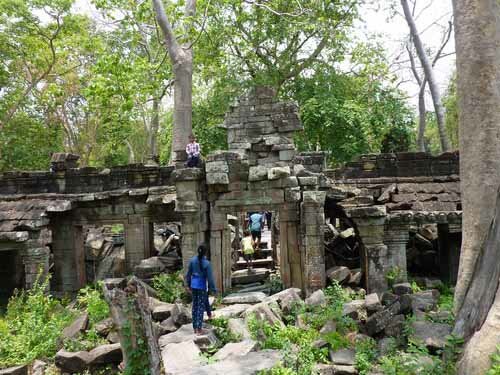
Mark 1. Some Kinnaris feature the head of an animal. Here there is a three-headed horse, a quite rare specimen.
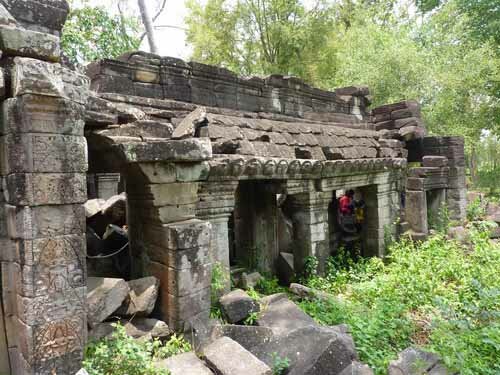
Mark 2. This bas-relief shows the different stages of the conflict between King Sisupala and Krishna: at the first scene young Śiśupāla shown on knees of Krishna what was the result that Sisupala missing two extra arms and a third eye with which he was born. Further in the center of the composition priest looks like Shiva holding a rosary. Here, apparently, refers to the scene failed marriage King Sisupala with beautiful Rukmini, who was in love with Krishna and He took by her request to Dwaraka for which Sisupala hated Krishna. Finally right, Krishna holding a sword (should be Sudarshan Chakra - disc weapon of Krishna), looking like a king, beheads the king Sisupala. Śiśupāla here depicted with his hands folded meekly showing that Sisupala got a liberation after the death because his whole mind was absorbed only in thoughts of Krishna despite the fact that these were thoughts of revenge.
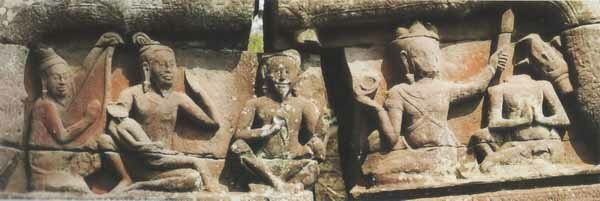
Mark 3. Many-armed figure looks like Shiva is depicted sitting. A small figure with a fan on the side possibly is his wife Parvati.


Mark 4. A god and his consort (heads missing) sit on a naga with, to the right, two standing figures holding bows. Possibly Rama and Lakshman in an unidentified scene from the Ramayana.
Mark 5. A multi-armed Shiva sits between Brahma and Vishnu.
Mark 6. This scene represents the sage Valmiki being enticed by Brahma to become the writer of the Ramayana epic. A quite rare appearance of Brahma as the central figure of a lintel. To the left a Brahmin plays the harp while at the right end a hunter wearing a hat in the shape of a bird has hit two cranes with his arrow .
Mark 7. Kinnaris decorate the gallery.


Mark 8. Probably Rama, mounted on an elephant, killing the multi-headed Ravana during the batde of Lanka.


Just pictures: nice lintels, decorations and Apsaras ...

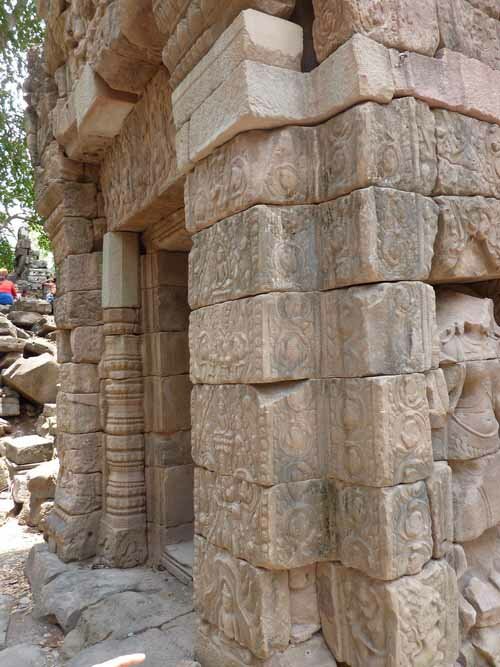
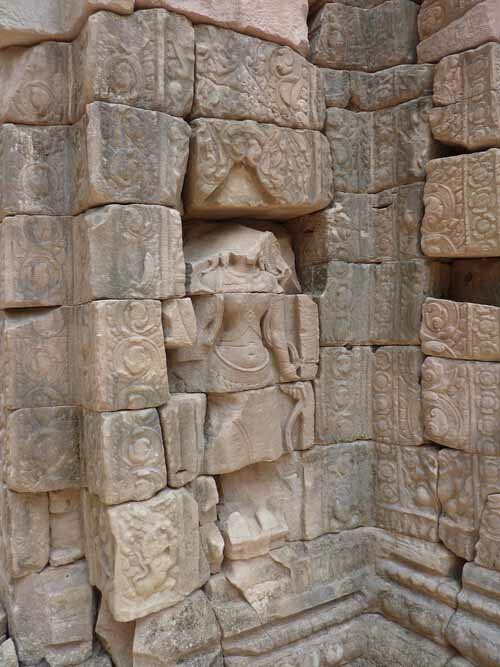


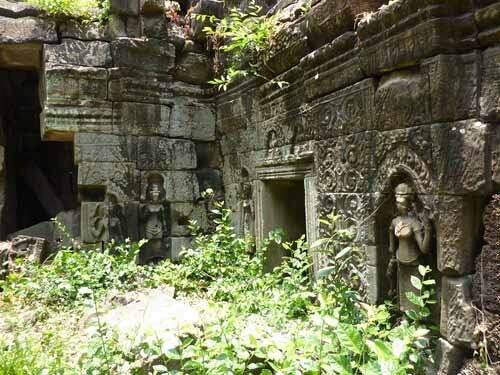
East Gallery

1. Land Battle
This panel reads from left to right. A mix of Khmer (in the upper register) and Cham soldiers (lower register) moves to the right. Jayavarman VII and a prince or general, perhaps his adopted Cham son Vidvanandana, stand at the top of a mountain, holding their bows.
The kings hair is tied in a bun with a tiny ornament figurine a standing Lokeshvara. The worshippers and ensign bearers to the right of the king. Further to the right, soldiers march down the mountain to join the fight.

To the left of the stream the Cham soldiers and their leader suggesting respect or obedience. To the right Khmer troops and Jayavarman VI1 also on his elephant pointing a finger at his defeated opponent.


The battle between this Khmer army and a Cham army takes place on grounds limited to the right by a river depicted by curvy lines bound the space with fish inside it.. The prince and the king are represented again on each side of the river fighting on top of their war elephants.

The battle rages on and further to the right the Chants are seen retreating.

A small vertical band, left uncarved, marks the beginning of a different scene centred on another representation of the same river, after the battle.

2. Naval Battle
This bas-relief look like the Bayon bas-relief where it shows a single Cham boat attacked by a Khmer armada. At Banteay Chhmar the forces in presence are balanced, which makes for a more realistic battle. Another significant difference is that at Banteay Chhmar Jayavarman VII is seen taking part in the fighting while he is absent from the battle at the Bayon. These elements may indicate that the Banteay Chhmar bas-relief depicts an actual naval battle while the Bayon bas-reliefs may only show a re-enactment organised for the benefit of the king..

Jayavarman VII appears here at the left end of the panel. He is wearing a square breast plate and the small Lokeshvara decorating his hair is depicted again. The king is standing on a platform lined w ith small naga balustrades, at the centre of a war boat featuring an elaborate prow in the shape of a devata-looking figure. The boatmen, using paddles, are represented facing the prow while in all other boats the oarsmen logically face the stern. Jayavarman VII is firing an arrow at the Cham general depicted to the right, at the centre of the panel. Otherwise, as in the Bayon bas-reliefs, both sides suffer heavy casualties in the violent clash. Soldiers fall from the boats, crocodiles lurk in the lakes waters, awaiting their prey.

3. To the right of the doorway the naval battle in process with the Khmers soldiers attacking from the right. In the right section of the panel near the walls top, the king sits in a palace guarded by rows of soldiers protected by large rectangular shields. Below a Victory dance is performed by a dancer on one leg. The gladiators are fighting like on a scene represented at the Bayon.
4. Король благословляет крестьян и их скот.
Выше розоватый камень с редким изображением многоголового и многорукого Шивы.
Слева священники выполняют обряд вокруг огня, разведённого в прекрасном храме.
A king is blessing farmers and their cattle. Above the pinkish stone with a rare representation of a multi-headed, multi-armed Shiva. To the left priests perform ritual around a fire set in a fine temple


1. This panel, the longest section of the bas-reliefs still standing, reads from right to left and depicts the Khmer army marching towards the east.
The king, probably Jayavarman VII himself, can be seen in his palace, at the right end of the panel. To the left of the palace a prince carrying a long stick ending with a rectangular blade. Below, at the base of the wall, have a look at the fish with a horse-head. Then, in a scene also depicted at the Bayon, two elephants are seen crossing a river on a bridge. Giant fish swim in the river.
The army continues to move to the left, the procession features the traditional elements: generals on their elephants, infantrymen, horsemen, princesses carried in palanquins, soldiers carrying the sacred arch, musicians and the gong. To the left of the section depicting the generals on their elephants three groups of soldiers carry loads on long platforms.
The second group from the right is intriguing. Above the platform a four-faced divinity in a sanctuary topped by a trident (badly eroded). To the left, the third group carries a small chariot with two wheels. Under it, four children are seen playing.

At the very left end of the wall a rather strange scene in which three men with bird's heads pay respect to the king who is arriving on foot from the left. An army procession develops towards the right, with two palanquins carrying a queen and a king. Then a beautiful temple where a linga is worshipped by the king and a priest. The dvarapalas and lions guarding the sanctuary and the fine coconut trees. At the base of the wall, small lingas in the riverbed. In the last section, to the left of the gong, a soldier carries a monkey on his shoulders and, below, an elephant drags the platform carrying war-prizes, two lingas taken away from the defeated Chams. At the base of the wall, several scenes of worship and rishis carrying goods on trays

Western Gallery

1. На нескольких камнях изображен Хануман, держащий Васуки за хвост. Это всё, что осталось от сцены «Пахтания Молочного Океана».. Остается только надеяться, что когда-нибудь вся эта панель будет восстановлена в своем былом великолепии.
Some panels depicts Hanuman holding Vasuki's tail. This is all that remains of the scene "Churning of the Ocean of Milk". One can only hope that someday this whole panel will be restored to its original splendor.
Panels A and B form an ensemble whose action reads from right to left.
2. At the right ot the door at the right end of the panel a prince sits in his palace. He is leaving on a chariot drawn by two horses moving to the left. Below men carry a heavy pyramidal object that they will load on a cart drawn hv bulls.
3. To the left ot the door the prince appears again on his chariot; he is holding up a small pyramidal object. He is then seen fighting a monster with the head of a lion.
At the base of the wall, the monster is shown devouring the bull. The driver of cart carries a large pyramidal object. An inscription mentions that a son of Jayavarman VII, Srindrakumara, defeated the monster Bharata Rahu who had attacked the palace of King Yashovarman I The left section of the wall shows a forest with three monkeys, an Asian rhinoceros and a deer. Then the prince, standing in a chariot drawn by two horses, commands his army, sword in hand.

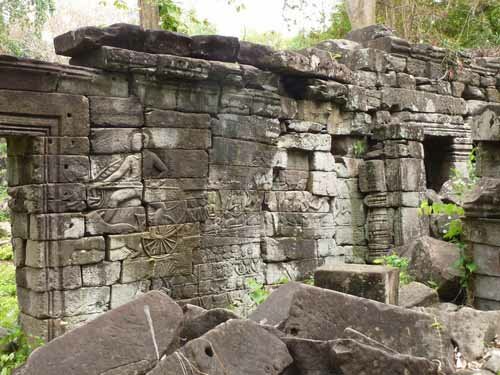
To the left the soldiers usually carrying the sacred arch are seen here transporting the small statue of a four-armed Vishnu. At the end of the wall the prince, hands joined, salutes the dignitaries he came to visit.

4. The two remaining multi-armed multi-headed Lokeshvaras in a section which once displayed eight carved images of the Bodhisattva . Sadly, the other ones were stolen, the last ones in the 1990s. To the left of the door Lokeshvara has twenty-two arms and is surrounded by ten medallions featuring apsaras holding a garland. Unfortunately the head of the god is badly eroded.
To the right of the door a smiling Lokeshvara with several heads and thirty-two arms is surrounded by worshippers. He holds a kendi with his left hand and a small Bodhisattva with four arms (Amitabha?) in his right hand .
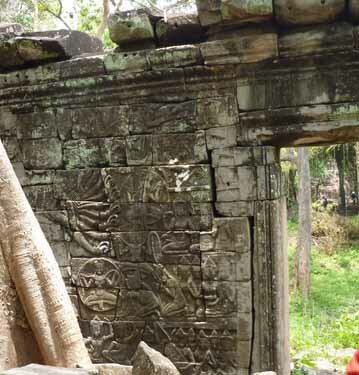

5. In the top register of this panel two princes a king and a prince are sitting in a palace. To the left priests are being served food. Below, men in a storehouse with sacks of rice are handing out food to the crowd. In the lower left section men compete to grab food hanging from a ceiling. The mood is festive during which food prizes were placed at the top of a pole. In this case the king probably organized festivities after a victory, rewarding his people with games and a food distribution.
Parmentier interpreted it in 1910 more darker. He saw groups of blind men given food during a famine. One of the two remaining multi-armed Lokeshvaras found on the western wall of the bas-reliefs. In the 1990s a large section of the wall was stolen. The looters, making their way to Bangkok, were arrested in Thailand. Two of the three recovered Lokeshvaras are now displayed in the National Museum in Phnom Penh.
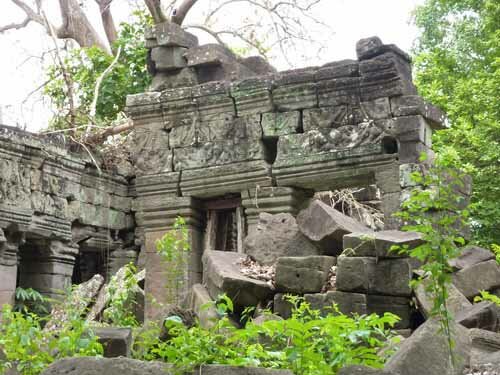
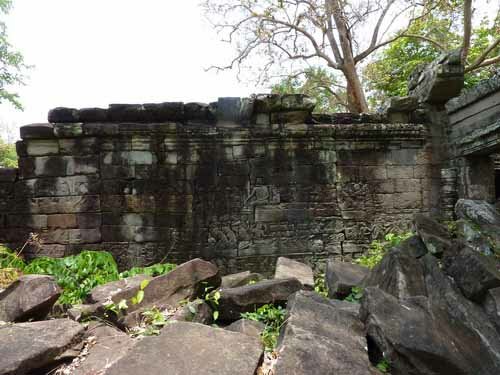
Southern Gallery

1. This bas-relief depicting the two severed heads show the governor refers to scenes of civil war, depicted also in Bayon. At both ends of the gallery (but not the wall) two groups khmer soldiers fighting each other. The excited crowd at a street market with a group of women in dispute, and the dead soldier lying on the ground, which again reminds reliefs Baiona.
2. The two sections lying on the ground are a door pillars with the images of Buddha.


Полуразрушенная южная гопура и галереи с колоннами цвета охры, выполняющими роль второго ограждения. От внешнего ограждения остался только фундамент и один ряд блоков на нем.
Half-ruined southern gopura and galleries with columns colored by ocher creates the second enclosure. From the outside enclosure remains only a foundation and a numbers of blocks on it.